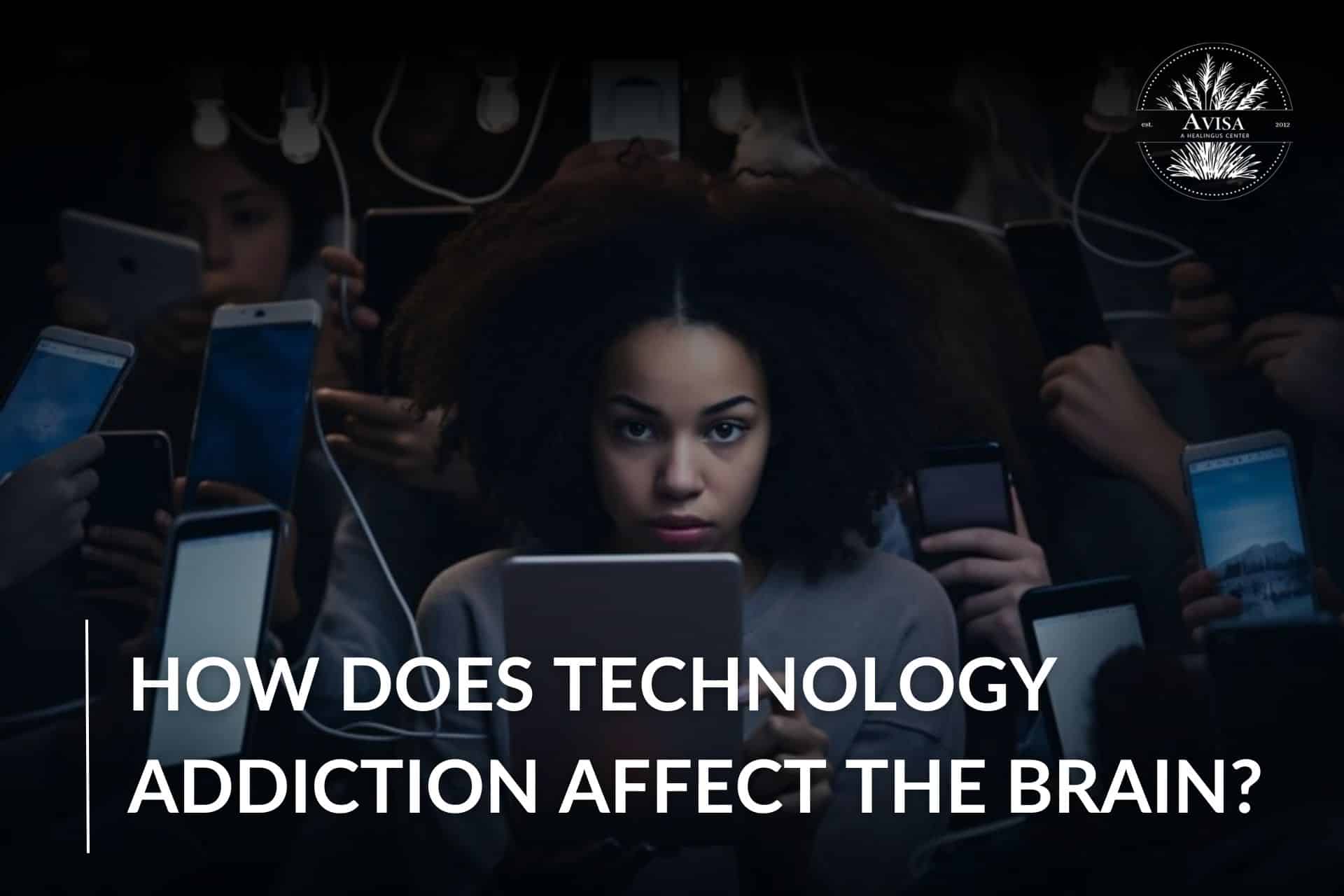Imagine your brain as a reward center, always looking for experiences that make you feel good. When you do things you enjoy, like spending time with friends or achieving a goal, your brain releases dopamine, a chemical that makes you feel pleasure.
This reward system motivates you to repeat those positive behaviors. However, in today’s digital world, technology can easily hijack this natural system. Social media, video games, and even news feeds are designed to keep you hooked, bombarding you with notifications, likes, and instant gratification.
This constant loop of artificial rewards fuels technology addiction, and you might not even realize how it affects your brain.
But this constant stimulation can have unintended consequences. How does technology addiction affect the brain? Let’s explore how it changes the brain’s chemistry, structure, and overall function, impacting our attention, memory, emotional well-being, and even decision-making abilities.
Looking to break the cycle of tech addiction?
Technology Addiction
Technology addiction refers to a compulsive and excessive reliance on digital devices and online activities, leading to negative consequences in various aspects of life. Individuals affected by technology addiction may prioritize digital engagement over other essential activities, experience withdrawal symptoms when not using technology, and struggle to control their usage despite recognizing its detrimental effects.
There are some Common terms used to describe technology addiction like,
- Internet addiction disorder (IAD): A term often used to describe excessive internet use leading to impaired functioning in daily life.
- Problematic Internet use: A broader term encompassing various problematic behaviors related to Internet and digital device use, including excessive gaming, social media use, and online shopping.
- Digital dependency: Refers to a reliance on digital technology for emotional fulfillment, social interaction, or escapism, often resulting in negative consequences.
Discussion on whether technology can become addictive.
The debate over whether technology can become addictive is ongoing. While technology addiction shares similarities with substance addiction in terms of compulsive behavior and neurological responses, some argue that the term “addiction” may not accurately capture the complexity of excessive technology use. Nevertheless, research suggests that prolonged and intense engagement with digital devices and online activities can lead to changes in brain function and behavior consistent with addiction.
What Are Some Technology Addictions?
The allure of technology can lead to various forms of addiction, each with its own set of characteristics and consequences:
- Gaming addiction: Excessive and compulsive gaming behavior, often characterized by loss of control, preoccupation with gaming, and withdrawal symptoms when not playing.
- Social media addiction: Obsessive use of social networking platforms, leading to neglect of real-life relationships, low self-esteem, and mood disturbances.
- Internet addiction: Broadly encompasses problematic internet use, including excessive browsing, online shopping, gambling, and viewing of explicit content.
- Smartphone addiction: Over-reliance on smartphones for communication, entertainment, and information, resulting in decreased productivity, disrupted sleep patterns, and social withdrawal.
These various forms of technology addiction underscore the multifaceted nature of the issue and highlight the need for comprehensive approaches to address it.
Signs & Symptoms of Technology Addiction
Recognizing the signs and symptoms of technology addiction is crucial in addressing its detrimental effects on individuals’ well-being.
Identifying signs and symptoms of technology addiction
- Increased preoccupation with digital devices or online activities.
- Difficulty in controlling the amount of time spent on technology.
- Neglect of personal responsibilities, such as work, school, or relationships, due to excessive technology use.
- Withdrawal symptoms, such as irritability, anxiety, or depression, when unable to access technology.
- Continued use of technology despite experiencing negative consequences, such as academic or occupational problems, financial difficulties, or strained relationships.
These signs may manifest as a constant urge to check notifications, browse social media, or play online games, often at the expense of other important tasks or social interactions.
Behavioral patterns associated with excessive technology use
- Constant checking of smartphones or other digital devices, even in inappropriate or potentially dangerous situations.
- Loss of interest in previously enjoyable activities or hobbies favoring technology-related pursuits.
- Social withdrawal and isolation, preferring online interactions over face-to-face communication.
- Disrupted sleep patterns, such as staying up late to use technology or experiencing sleep disturbances due to excessive screen time.
- Physical symptoms, such as eyestrain, headaches, or musculoskeletal discomfort, resulting from prolonged technology use.
Individuals may find themselves spending increasingly more time online, feeling a sense of anxiety or restlessness when separated from their devices, and experiencing negative impacts on their mental and physical health.
How does technology addiction affect the brain?
Understanding the impact of technology addiction on the brain is essential in comprehending the full scope of its consequences.
1. Explanation of the brain’s reward system
The brain’s reward system is a complex neural circuit network regulating motivation, pleasure, and reinforcement. It operates on a feedback loop, where rewarding stimuli trigger the release of neurotransmitters, such as dopamine, which promote feelings of pleasure and encourage repeated behaviors.
2. Role of dopamine in technology addiction
Dopamine plays a central role in technology addiction by mediating the brain’s response to rewarding stimuli. When individuals engage in technology-related activities, such as gaming or social media browsing, dopamine is released in the brain, reinforcing the behavior and contributing to the development of addictive patterns.
3. Mechanisms of how does technology addiction affect brain function
Prolonged and excessive technology use can lead to structural and functional changes in the brain. Studies have shown that frequent engagement with digital devices can alter neural connectivity, particularly in regions associated with attention, memory, and emotional regulation. Additionally, the constant bombardment of stimuli from technology can lead to cognitive overload and decreased cognitive control.
4. Neurological consequences of prolonged technology addiction
The neurological consequences of prolonged technology addiction can be profound and wide-ranging. Chronic exposure to digital stimuli has been associated with deficits in attention, impaired decision-making abilities, and increased risk of mood disorders, such as depression and anxiety. Furthermore, excessive screen time has been linked to changes in brain structure, including reduced gray matter volume in regions critical for cognitive function.
By understanding the impact of how does technology addiction affect the brain, individuals and healthcare professionals can develop targeted interventions and treatment strategies to address its adverse effects and promote healthier technology habits.
Mitigation and Management
Effectively mitigating and managing technology addiction requires a multifaceted approach that addresses both individual behaviors and societal influences.
Strategies for preventing and managing technology addiction
- Set boundaries: Establish clear guidelines for technology use, including designated times for device usage and screen-free zones in the home.
- Monitor usage: Use tracking tools or apps to monitor screen time and set limits on specific apps or websites.
- Practice mindfulness: Encourage mindfulness techniques, such as meditation or deep breathing exercises, to promote awareness of technology use and reduce compulsive behaviors.
- Encourage alternative activities: Encourage engagement in offline activities, such as hobbies, sports, or social interactions, to reduce reliance on digital devices for entertainment or social connection.
- Seek professional help: If technology addiction is causing significant distress or impairment, seek support from mental health professionals, who can provide counseling, therapy, or specialized treatment programs.
Importance of promoting healthy technology habits
- Foster digital literacy: Educate individuals, especially children and adolescents, about the potential risks and benefits of technology, empowering them to make informed decisions about their digital behaviors.
- Cultivate a balanced lifestyle: Emphasize the importance of maintaining a balanced lifestyle that includes adequate sleep, physical activity, and face-to-face social interactions alongside technology use.
- Promote digital wellness: Encourage the adoption of digital wellness practices, such as digital detoxes, screen-free activities, and mindful technology use, to foster a healthier relationship with technology.
- Advocate for policy changes: Advocate for policies and regulations that promote responsible technology use, including age restrictions on social media platforms, limits on advertising targeted at children, and support for digital literacy education in schools.
These are the strategies for promoting healthy technology habits; individuals, families, and communities can effectively mitigate the negative impact of technology addiction and cultivate a more balanced and fulfilling relationship with digital technology.
Tired of fighting addiction and mental health struggles?
Ignoring both deepens the struggle. Our holistic approach—detox, therapy, and medication-assisted treatment—can help you heal. Take the first step today.
FAQs
1. How does too much technology affect the brain?
Excessive internet use not only impairs cognitive functions but also correlates with heightened risks of depression and anxiety, potentially inducing feelings of isolation and overwhelm.
2. Does Internet addiction alter the brain?
Internet addiction, classified as a behavioral addiction, initiates alterations in the brain’s reward system, providing the brain with an elevated sense of pleasure. Nevertheless, this condition may also harm the structure and functionality of crucial brain systems involved in reward processing, executive function, and decision-making.
3. How does addiction affect the brain?
Substances like drugs or alcohol can seize control of the pleasure and reward pathways in your brain, fostering an insatiable craving for more. Additionally, addiction can hyperactivate your brain’s emotional threat detection circuits, leading to heightened feelings of anxiety and stress during periods of abstinence from drugs or alcohol.
Conclusion
In conclusion, understanding how technology addiction affects the brain is crucial for addressing its impact on individuals’ well-being and society as a whole. From altering brain chemistry and structure to influencing cognitive function and emotional well-being, technology addiction can have far-reaching consequences. By recognizing the signs and symptoms of technology addiction, promoting healthy technology habits, and implementing strategies for mitigation and management, individuals.
Let’s work together to create a future where technology enhances our lives without compromising our well-being.
Join Avisa in promoting digital wellness and building a healthier relationship with technology. Together, we can make a positive difference in our communities and beyond.











